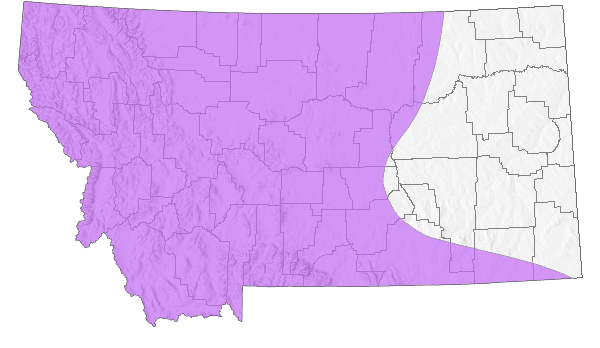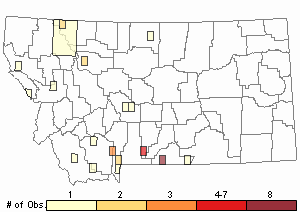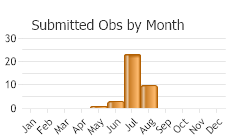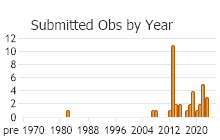View in other NatureServe Network Field Guides
NatureServe
Montana
Utah
Wyoming
Idaho
Wisconsin
British Columbia
South Carolina
Yukon
California
New York
Rocky Mountain Parnassian - Parnassius smintheus
Native Species
Global Rank:
G5
State Rank:
S5
Agency Status
USFWS:
USFS:
BLM:
External Links
General Description
Not all authorities have agreed on the specific status of members in the Parnassius smintheus group (see Ferris 1976; Scott 1986; Guppy and Shepard 2001; Pyle 2002; Warren 2005; Schoville and Roderick 2009), with some treating P. smintheus as a subspecies of P. phoebus, others treating P. smintheus and P. phoebus as full species, currently the accepted status. Given past taxonomic uncertainty and instability, this account might include information pertaining to more than one species.
[From Ferris and Brown 1981; Scott 1986; Opler and Wright 1999; Glassberg 2001; Pyle 2002] Forewing 2.4-3.6 cm. Antennae with alternating black and white rings and black club, abdomen and front of face with yellow hairs. Uppersurface white (possibly with extensive sooty overscaling), forewing usually with bottom of black bar in cell rounded and not reaching bottom of cell, at least two small red spots near leading edge, male with black submarginal band and usually a median black spot on towards trailing edge; hindwing with at least two red spots (red more extensive in females). Undersurface usually with more extensive red markings but otherwise similar to uppersurface.
Phenology
One flight, mostly June at low elevation, July to mid-August at high elevation (Scott 1986). Late May to August in the Rocky Mountains (Glassberg 2001). Mid-May to late August in Colorado (Emmel 1964; Scott and Scott 1978; Scott and Epstein 1987), late April to mid-October in Oregon and Washington (Pyle 2002), late June to late August in Oregon (Warren 2005), early June to late September in British Columbia (Guppy and Shepard 2001).
Diagnostic Characteristics
Best determined by a combination of large size, white base color with darkest markings black (not grayish), red spots on both forewings and hindwings, alternating black and white bands on antennae, face with yellowish hairs (not white).
Species Range
Montana Range
Range Descriptions

 Native
Native
Range Comments
Southeastern Alaska Panhandle, northwestern British Columbia and southern Yukon, south in Rocky Mountains and hills on high plains to northwestern California, northeastern Nevada, southeastern Utah, northern New Mexico, east to the Black Hills of South Dakota and western Nebraska (Ferris 1976; Scott 1986; Opler and Wright 1999; Glassberg 2001; Guppy and Shepard 2001); 2134 m to at least 4267 m elevation in Colorado (Brown 1957; Ferris and Brown 1981; Scott and Scott 1978), 1371 m to at least 3292 m elevation in Wyoming (Ferris 1976; Ferris and Brown 1981), 884 m to 2530 m elevation in Oregon (Warren 2005), 456 m to at least 2134 m elevation in British Columbia (Threatful 1988; Guppy 1998). In Montana, reported from at least 37 counties in the western 2/3 of the state, east in the north to Phillips County, in the south to Big Horn County (Kohler 1980; Stanford and Opler 1993; FLMNH Lepidopterists' Society database), 975 m to at least 3200 m elevation (Ferris 1976; Hendricks 1986). Common in the Rocky Mountains (Glassberg 2001).
Observations in Montana Natural Heritage Program Database
Number of Observations: 60
(Click on the following maps and charts to see full sized version)
Map Help and Descriptions
Relative Density

Recency



 (Observations spanning multiple months or years are excluded from time charts)
(Observations spanning multiple months or years are excluded from time charts)
Migration
Non-migratory. Maximum distances moved by marked adults less than 2.0 km (Scott 1975c; Roland et al. 2000; Matter et al. 2004).
Habitat
Foothill canyons, sagebrush flats, montane meadows, glacial moraines, above treeline in rocky alpine terrain (Ferris and Brown 1981; Scott 1986; Guppy 1998; Opler and Wright 1999; Glassberg 2001; Guppy and Shepard 2001; Pyle 2002). In Glacier National Park, Montana reported from alpine terrain (Debinski 1993); in the Greater Yellowstone Ecosystem, reported from xeric montane meadows dominated by sagebrush, other high-elevation rocky habitats (Debinski and Pritchard 2002; Debinski et al. 2013).
Food Habits
Larval food plants are members of the Crassulaceae, particularly several species of Sedum (Ferris and Brown 1981; Scott 1986, 1992, 2006; Guppy and Shepard 2001; Pyle 2002; Warren 2005; James and Nunnallee 2011). Adults feed on flower nectar (including Achillea, Agoseris, Antennaria, Apocynum, Arenaria, Arnica, Astragalus, Ceanothus, Chrysothamnus, Cirsium, Erigeron, Eriogonum, Erysimum, Gaillardia, Geum, Gutierrezia, Haplopappus, Harbouria, Helianthus, Heterotheca, Hymenoxys, Jamesia, Lesquerella, Monarda, Physocarpus, Polygonum, Potentilla, Rudbeckia, Scutellaria, Sedum, Senecio, Taraxacum, Tragopogon), sap, and mud (Scott 2014).
Reproductive Characteristics
Females lay eggs laid singly and haphazardly on soil, litter, rocks, other plant species near host plant (Scott 1986, 1992, 2006; Guppy and Shepard 2001; Pyle 2002; James and Nunnallee 2011). Up to 95 eggs laid by a single female, egg viability (proportion of eggs hatching) averages 46% (Matter et al. 2006). Eggs may overwinter with a well-developed embryo (L1 instar), hatch within 2 days of exposure to warm temperatures, reach L3 instar 13-14 days after egg-hatch, total larval period to L5 instar and pupa 70-84 days, adults eclose (emerge from pupae) in about 14 days (Guppy and Shepard 2001; James and Nunnallee 2011). Larvae feed nocturnally mostly on leaf tips, rest openly or concealed on host plant, build no nest, may overwinter as older larvae or pupae in some northern areas, pupate in thin cocoon on ground in litter (Scott 1979, 1986; Guppy and Shepard 2001; James and Nunnallee 2011). Males patrol throughout the day low to the ground near host plant in search of females. Males mate preferentially with young virgin females, sometimes before females have expanded their wings upon emergence from pupae. Copulation lengthy (several hours); male then secretes a waxy sphragis on female abdomen to prevent further mating (Scott 1975b, Scott 1986; James and Nunnallee 2011; Matter et al. 2012).
Stewardship Responsibility
References
- Literature Cited AboveLegend:
 View Online Publication
View Online Publication Brown, F.M. 1957. Colorado Butterflies. Proceedings; Numbers Three through Seven. Denver Museum of Natural History, Denver, Co.
Brown, F.M. 1957. Colorado Butterflies. Proceedings; Numbers Three through Seven. Denver Museum of Natural History, Denver, Co. Debinski, D. 1993. Butterflies of Glacier National Park, Montana. Occasional Papers of the Museum of Natural History, the University of Kansas, Lawrence, Kansas. No. 159: 1-13.
Debinski, D. 1993. Butterflies of Glacier National Park, Montana. Occasional Papers of the Museum of Natural History, the University of Kansas, Lawrence, Kansas. No. 159: 1-13. Debinski, D.M. and J.A. Pritchard. 2002. A field guide to the butterflies of the Greater Yellowstone Ecosystem. Lanham, MD: Roberts Rinehart Publishers. 107 p.
Debinski, D.M. and J.A. Pritchard. 2002. A field guide to the butterflies of the Greater Yellowstone Ecosystem. Lanham, MD: Roberts Rinehart Publishers. 107 p. Debinski, D.M., J.C. Caruthers, D. Cook, J. Crowley, and H. Wickham. 2013. Gradient-based habitat affinities predict species vulnerability to drought. Ecology 94(5): 1036-1045.
Debinski, D.M., J.C. Caruthers, D. Cook, J. Crowley, and H. Wickham. 2013. Gradient-based habitat affinities predict species vulnerability to drought. Ecology 94(5): 1036-1045. Emmel, T.C. 1964. The ecology and distribution of butterflies in a montane community near Florissant, Colorado. American Midland Naturalist 72(2): 358-373.
Emmel, T.C. 1964. The ecology and distribution of butterflies in a montane community near Florissant, Colorado. American Midland Naturalist 72(2): 358-373. Ferris, C.D. 1976. A proposed revision of non-Arctic Parnassius phoebus Fabricius in North America (Papilionidae). Journal of Research on the Lepidoptera. 15: 1-22.
Ferris, C.D. 1976. A proposed revision of non-Arctic Parnassius phoebus Fabricius in North America (Papilionidae). Journal of Research on the Lepidoptera. 15: 1-22. Ferris, C.D. and F.M. Brown (eds). 1981. Butterflies of the Rocky Mountains. Univ. of Oklahoma Press. Norman. 442 pp.
Ferris, C.D. and F.M. Brown (eds). 1981. Butterflies of the Rocky Mountains. Univ. of Oklahoma Press. Norman. 442 pp. Glassberg, J. 2001. Butterflies through Binoculars: A Field Guide to the Butterflies of Western North America. Oxford University Press.
Glassberg, J. 2001. Butterflies through Binoculars: A Field Guide to the Butterflies of Western North America. Oxford University Press. Guppy, C.S. 1998. Notes on Parnassius smintheus Doubleday (Papilionidae) on Vancouver Island. Journal of the Lepidopterists' Society. 52: 115-118.
Guppy, C.S. 1998. Notes on Parnassius smintheus Doubleday (Papilionidae) on Vancouver Island. Journal of the Lepidopterists' Society. 52: 115-118. Guppy, C.S. and J.H. Shepard. 2001. Butterflies of British Columbia: including western Alberta, southern Yukon, the Alaska Panhandle, Washington, northern Oregon, northern Idaho, northwestern Montana. UBC Press (Vancouver, BC) and Royal British Columbia Museum (Victoria, BC). 414 pp.
Guppy, C.S. and J.H. Shepard. 2001. Butterflies of British Columbia: including western Alberta, southern Yukon, the Alaska Panhandle, Washington, northern Oregon, northern Idaho, northwestern Montana. UBC Press (Vancouver, BC) and Royal British Columbia Museum (Victoria, BC). 414 pp. Hendricks, P. 1986. Avian predation of alpine butterflies. Journal of the Lepidopterists' Society 40(2): 129.
Hendricks, P. 1986. Avian predation of alpine butterflies. Journal of the Lepidopterists' Society 40(2): 129. James, D.G. and D. Nunnallee. 2011. Life histories of Cascadia butterflies. Corvallis, OR: Oregon State University Press. 447 p.
James, D.G. and D. Nunnallee. 2011. Life histories of Cascadia butterflies. Corvallis, OR: Oregon State University Press. 447 p. Kohler, S. 1980. Checklist of Montana Butterflies (Rhopalocera). Journal of the Lepidopterists' Society 34(1): 1-19.
Kohler, S. 1980. Checklist of Montana Butterflies (Rhopalocera). Journal of the Lepidopterists' Society 34(1): 1-19. Matter, S.F., A. Wick, M. Gaydos, M. Frantz, and J. Roland. 2006. Egg viability and larval contribution to fecundity of Parnassius smintheus Doubleday (Papilionidae). Journal of the Lepidopterists' Society 60:228-230.
Matter, S.F., A. Wick, M. Gaydos, M. Frantz, and J. Roland. 2006. Egg viability and larval contribution to fecundity of Parnassius smintheus Doubleday (Papilionidae). Journal of the Lepidopterists' Society 60:228-230. Matter, S.F., B. Reed, K. Illerbrun, A. Doyle, S. McPike, and J. Roland. 2012. Young love? Mating of Parnassius smintheus Doubleday (Papilionidae). Journal of the Lepidopterists' Society. 66(2): 111-113.
Matter, S.F., B. Reed, K. Illerbrun, A. Doyle, S. McPike, and J. Roland. 2012. Young love? Mating of Parnassius smintheus Doubleday (Papilionidae). Journal of the Lepidopterists' Society. 66(2): 111-113. Matter, S.F., J. Roland, A. Moilanen, and I. Hanski. 2004. Migration and survival of Parnassius smintheus: detecting effects of habitat for individual butterflies. Ecological Applications. 14(5): 1526-1534.
Matter, S.F., J. Roland, A. Moilanen, and I. Hanski. 2004. Migration and survival of Parnassius smintheus: detecting effects of habitat for individual butterflies. Ecological Applications. 14(5): 1526-1534. Opler, P.A. and A.B. Wright. 1999. A field guide to western butterflies. Second edition. Peterson Field Guides. Houghton Mifflin Company, Boston, Massachusetts. 540 pp.
Opler, P.A. and A.B. Wright. 1999. A field guide to western butterflies. Second edition. Peterson Field Guides. Houghton Mifflin Company, Boston, Massachusetts. 540 pp. Pyle, R.M. 2002. The butterflies of Cascadia: a field guide to all the species of Washington, Oregon, and surrounding territories. Seattle Audubon Society, Seattle, Washington. 420 pp.
Pyle, R.M. 2002. The butterflies of Cascadia: a field guide to all the species of Washington, Oregon, and surrounding territories. Seattle Audubon Society, Seattle, Washington. 420 pp. Roland, J., N. Keyghobadi, and S. Fownes. 2000. Alpine Parnassius butterfly dispersal: effects of landscape and population size. Ecology. 81(6): 1642-1653.
Roland, J., N. Keyghobadi, and S. Fownes. 2000. Alpine Parnassius butterfly dispersal: effects of landscape and population size. Ecology. 81(6): 1642-1653. Schoville, S.D. and G.K. Roderick. 2009. Alpine biogeography of Parnassian butterflies during Quaternary climate cycles in North America. Molecular Ecology 18(16): 3471-3485.
Schoville, S.D. and G.K. Roderick. 2009. Alpine biogeography of Parnassian butterflies during Quaternary climate cycles in North America. Molecular Ecology 18(16): 3471-3485. Scott, J.A. 1975b. Mate-locating behavior of western North American butterflies. Journal of Research on the Lepidoptera 14:1-40.
Scott, J.A. 1975b. Mate-locating behavior of western North American butterflies. Journal of Research on the Lepidoptera 14:1-40. Scott, J.A. 1975c. Flight patterns among eleven species of diurnal Lepidoptera. Ecology 56(6): 1367-1377.
Scott, J.A. 1975c. Flight patterns among eleven species of diurnal Lepidoptera. Ecology 56(6): 1367-1377. Scott, J.A. 1979. Hibernal diapause of North American Papilionoidea and Hesperioidea. Journal of Research on the Lepidoptera 18(3): 171-200.
Scott, J.A. 1979. Hibernal diapause of North American Papilionoidea and Hesperioidea. Journal of Research on the Lepidoptera 18(3): 171-200. Scott, J.A. 1986. The butterflies of North America: a natural history and field guide. Stanford University Press, Stanford, California.
Scott, J.A. 1986. The butterflies of North America: a natural history and field guide. Stanford University Press, Stanford, California. Scott, J.A. 1992. Hostplant records for butterflies and skippers (mostly from Colorado) 1959-1992, with new life histories and notes on oviposition, immatures, and ecology. Papilio new series #6. 185 p.
Scott, J.A. 1992. Hostplant records for butterflies and skippers (mostly from Colorado) 1959-1992, with new life histories and notes on oviposition, immatures, and ecology. Papilio new series #6. 185 p. Scott, J.A. 2006. Butterfly hostplant records, 1992-2005, with a treatise on the evolution of Erynnis, and a note on new terminology for mate-locating behavior. Papilio new series #14. 74 p.
Scott, J.A. 2006. Butterfly hostplant records, 1992-2005, with a treatise on the evolution of Erynnis, and a note on new terminology for mate-locating behavior. Papilio new series #14. 74 p. Scott, J.A. 2014. Lepidoptera of North America 13. Flower visitation by Colorado butterflies (40,615 records) with a review of the literature on pollination of Colorado plants and butterfly attraction (Lepidoptera: Hersperioidea and Papilionoidea). Contributions of the C.P. Gillette Museum of Arthopod Diversity. Fort Collins, CO: Colorado State University. 190 p.
Scott, J.A. 2014. Lepidoptera of North America 13. Flower visitation by Colorado butterflies (40,615 records) with a review of the literature on pollination of Colorado plants and butterfly attraction (Lepidoptera: Hersperioidea and Papilionoidea). Contributions of the C.P. Gillette Museum of Arthopod Diversity. Fort Collins, CO: Colorado State University. 190 p. Scott, J.A. and G.R. Scott. 1978. Ecology and distribution of the butterflies of southern central Colorado. Journal of Research on the Lepidoptera 17(2): 73-128.
Scott, J.A. and G.R. Scott. 1978. Ecology and distribution of the butterflies of southern central Colorado. Journal of Research on the Lepidoptera 17(2): 73-128. Scott, J.A. and M.E. Epstein. 1987. Factors affecting phenology in a temperate insect community. American Midland Naturalist 117(1): 103-118.
Scott, J.A. and M.E. Epstein. 1987. Factors affecting phenology in a temperate insect community. American Midland Naturalist 117(1): 103-118. Stanford, R.E. and P.A. Opler. 1993. Atlas of western USA butterflies: including adjacent parts of Canada and Mexico. Unpubl. Report. Denver and Fort Collins, Colorado 275 pp.
Stanford, R.E. and P.A. Opler. 1993. Atlas of western USA butterflies: including adjacent parts of Canada and Mexico. Unpubl. Report. Denver and Fort Collins, Colorado 275 pp. Threatful, D.L. 1988. A list of the butterflies and skippers of Mount Revelstoke and Glacier National Parks, British Columbia, Canada (Lepidoptera). Journal of Research on the Lepidoptera 27(3-4): 213-221.
Threatful, D.L. 1988. A list of the butterflies and skippers of Mount Revelstoke and Glacier National Parks, British Columbia, Canada (Lepidoptera). Journal of Research on the Lepidoptera 27(3-4): 213-221. Warren, A.D. 2005. Lepidoptera of North America 6: Butterflies of Oregon, their taxonomy, distribution, and biology. Contributions of the C. P. Gillette Museum of Arthropod Diversity, Colorado State University. Fort Collins, Colorado. 406 pp.
Warren, A.D. 2005. Lepidoptera of North America 6: Butterflies of Oregon, their taxonomy, distribution, and biology. Contributions of the C. P. Gillette Museum of Arthropod Diversity, Colorado State University. Fort Collins, Colorado. 406 pp.
- Additional ReferencesLegend:
 View Online Publication
View Online Publication
Do you know of a citation we're missing? Allen, T.J., J.P. Brock, and J. Glassberg. 2005. Caterpillars in the field and garden: a field guide to the butterfly caterpillars of North America. Oxford University Press.
Allen, T.J., J.P. Brock, and J. Glassberg. 2005. Caterpillars in the field and garden: a field guide to the butterfly caterpillars of North America. Oxford University Press. Brock, J.P. and K. Kaufman. 2003. Kaufman Field Guide to Butterflies of North America. Houghton Mifflin Company, New York, NY 284 pp.
Brock, J.P. and K. Kaufman. 2003. Kaufman Field Guide to Butterflies of North America. Houghton Mifflin Company, New York, NY 284 pp. Caruthers, J.C., and D. Debinski. 2006. Montane meadow butterfly species distributions in the Greater Yellowstone Ecosystem. University of Wyoming National Park Service Research Center Annual Report, 2006. Vol. 30, Art. 14. 85-96.
Caruthers, J.C., and D. Debinski. 2006. Montane meadow butterfly species distributions in the Greater Yellowstone Ecosystem. University of Wyoming National Park Service Research Center Annual Report, 2006. Vol. 30, Art. 14. 85-96. Forister, M.L., C.A. Halsch, C.C. Nice, J.A. Fordyce, T.E. Dilts, J.C. Oliver, K.L. Prudic, A.M. Shapiro, J.K. Wilson, J. Glassberg. 2021. Fewer butterflies seen by community scientists across the warming and drying landscapes of the American West. Science 371:1042-1045.
Forister, M.L., C.A. Halsch, C.C. Nice, J.A. Fordyce, T.E. Dilts, J.C. Oliver, K.L. Prudic, A.M. Shapiro, J.K. Wilson, J. Glassberg. 2021. Fewer butterflies seen by community scientists across the warming and drying landscapes of the American West. Science 371:1042-1045. Hendricks, P. and M. Roedel. 2001. A faunal survey of the Centennial Valley Sandhills, Beaverhead County, Montana. Report to the U.S. Bureau of Land Management and U.S. Fish and Wildlife Service. Montana Natural Heritage Program, Helena, MT. 44 p.
Hendricks, P. and M. Roedel. 2001. A faunal survey of the Centennial Valley Sandhills, Beaverhead County, Montana. Report to the U.S. Bureau of Land Management and U.S. Fish and Wildlife Service. Montana Natural Heritage Program, Helena, MT. 44 p. Layberry, R.A., P.W. Hall, and J.D. LaFontaine. 1998. The Butterflies of Canada. University of Toronto Press. 280 pp. + color plates.
Layberry, R.A., P.W. Hall, and J.D. LaFontaine. 1998. The Butterflies of Canada. University of Toronto Press. 280 pp. + color plates. Maxell, B.A. 2016. Northern Goshawk surveys on the Beartooth, Ashland, and Sioux Districts of the Custer-Gallatin National Forest: 2012-2014. Montana Natural Heritage Program. Helena, MT. 114pp.
Maxell, B.A. 2016. Northern Goshawk surveys on the Beartooth, Ashland, and Sioux Districts of the Custer-Gallatin National Forest: 2012-2014. Montana Natural Heritage Program. Helena, MT. 114pp.
- Web Search Engines for Articles on "Rocky Mountain Parnassian"
- Additional Sources of Information Related to "Insects"





